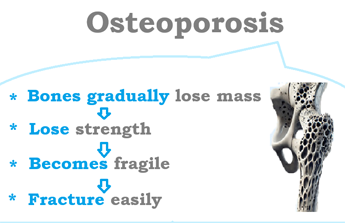What is Osteoporosis?
Osteoporosis is a bone disease that causes bones to become thin, weak, and fragile. This loss of bone strength makes fractures more likely, even from simple movements such as bending, coughing, or daily activities.
The most common fractures related to osteoporosis occur in the spine, wrist, and hip.

Risk Factors for Osteoporosis
Several risk factors increase the likelihood of developing osteoporosis, including:
Being female, age 50 or older, or postmenopausal
Low calcium, vitamin D, vitamin K, and vitamin B12 intake
Sedentary lifestyle and low physical activity
Thin body frame
Long-term use of steroids (prednisone) or thyroid medications
Smoking and alcohol abuse
Medical conditions like intestinal diseases, chronic kidney or liver disease
Hormonal imbalance such as hyper-active thyroid disease (hyperthyroidism)
Prolonged heavy metal exposure (lead, cadmium, etc.)
Osteoporosis in women is much more common than in men. However, men can also develop osteoporosis, especially with advancing age and poor lifestyle choices.
Symptoms of Osteoporosis
Osteoporosis is often known as a “silent disease” because it usually develops without noticeable symptoms. In most cases, people find out they have it only after a bone density test or a fracture.
One of the early signs can be a gradual loss of height caused by spinal compression fractures. These occur when weak vertebrae collapse and change shape from rectangular to triangular, leading to curved posture, back pain, and reduced height.
Importantly, osteoporosis does not cause pain unless a bone is fractured.
A bone density test is the standard way to diagnose osteoporosis. It is usually measured using a dual-energy X-ray absorptiometry (DEXA) scan.
Osteoporosis is defined when bone density is 2.5 standard deviations below that of a healthy young adult.
Prevention of Osteoporosis
Preventing osteoporosis involves adopting a bone-healthy lifestyle that includes:
1Weight-Bearing Exercises
Regular exercise stimulates bone strength and helps prevent bone loss. Effective exercises for elderly include:
Brisk walking outdoors or on a treadmill
Gentle aerobics
Stair climbing
Bicycling (less than 5 mph)
Yoga and Stretching.
Light weight training.
Leisurely sports (table tennis, playing catch, fishing)
Light yard and house work.
2 Calcium and Vitamin D-Rich Diet
Eating calcium-rich foods helps maintain bone density. Good sources include:
Whole cereals like ragi (finger millet), pseudocereals (amaranth, buckwheat)
Plant-based milks, like soy milk
Nuts, especially almonds
Vitamin D is essential for calcium absorption. Best sources are:
Eggs and lean meats
3 Lifestyle Modifications
Avoid smoking and excess alcohol
Limit long-term use of medications that weaken bones
Women entering menopause should discuss osteoporosis screening with their doctor
In Summary
Preventing and managing osteoporosis relies on early diagnosis, proper nutrition, regular exercise, and healthy lifestyle habits.
Maintaining strong bones with enough calcium, vitamin D, and weight-bearing activities can lower the risk of fractures. These steps help both men and women stay active and independent as they age.
Medical Disclaimer.
Read further on:
≺≺ What Is the Ketogenic Diet? Is the Keto Diet Right for Everyone?
≺≺ Why should I combine Avocados and Tomatoes?
≺≺ Cholesterol: What Does Diet Have to Do with It?
≺≺ Which food is most associated with helping people live longer?
≺≺ Is Plant-Based Protein the Key to a Longer, Stronger Life?
≺≺ How important is fiber in the diet?
≺≺ What cardiovascular benefits do berries provide?
≺≺ What is the Okinawan diet? What is the secret behind Okinawan long life-expectancy?
≺≺ Ultra-Processed Foods: What They Are, Why They’re Harmful, and How to Cut Back.
≺≺ What grains have the lowest glycemic index?
≺≺ How Important Is Protein for Your Health?
≺≺ is your kid getting too much protein?
≺≺ What foods and vitamins are good for your skin?
≺≺ EWG's- The Clean Fifteen: Fruits and Vegetables with the Lowest Pesticide Levels.
≺≺ What eating strategies work best for losing weight long term?
≺≺ How Do Sugary Meals and Beverages Harm Dental Health?
≺≺ Why Vitamin B12 Is Important for Your Health?
≺≺ What foods should people with high blood pressure avoid?
≺≺ What food is most effective for moderating blood sugar?
≺≺ What are antioxidants? How antioxidants in the fruits and vegetables help in preventing cancers and diseases?
≺≺ How can I reduce the risk of cancer-causing chemicals when cooking or grilling meat?
≺≺ What happens to my blood vessels when I gain weight?
≻≻ Watch this page for more such informative articles on Health, Nutrition, and Wellness.
≻≻-Back to Home page.
Further reading (External Links opens in new window):
≺≺- Harvard Health Publishing - Osteoporosis.